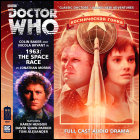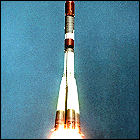 The TARDIS brings the Doctor and Peri to Kazakhstan in November 1963, and they happen upon a wrecked car with three dead passengers – all of them executed prior to the wreck. When they spot a second vehicle, the Doctor and Peri “borrow” identity papers from the corpses and are picked up and whisked away to the Baikonur Cosmodrome, the heart of the Soviet Union’s space program, where mission controllers are frantically trying to reach Vostok 7, a mission to send a cosmonaut around the moon and return her to Earth. Posing as two scientists from Moscow, the Doctor and Peri discover that something has gone disastrously wrong with this mission, which probably has something to do with why it’s been erased from official history. The Doctor manages to restore contact with Vostok 7 and help the engineers fly it by remote back to Earth, only to discover that inside the capsule is a live dog with a human voice – a dog the Doctor recognizes as Laika, the first living Earth creature sent into space. But why is Laika now speaking with the voice of the first woman to go around the moon, and what other secrets await the next visitors to the moon?
The TARDIS brings the Doctor and Peri to Kazakhstan in November 1963, and they happen upon a wrecked car with three dead passengers – all of them executed prior to the wreck. When they spot a second vehicle, the Doctor and Peri “borrow” identity papers from the corpses and are picked up and whisked away to the Baikonur Cosmodrome, the heart of the Soviet Union’s space program, where mission controllers are frantically trying to reach Vostok 7, a mission to send a cosmonaut around the moon and return her to Earth. Posing as two scientists from Moscow, the Doctor and Peri discover that something has gone disastrously wrong with this mission, which probably has something to do with why it’s been erased from official history. The Doctor manages to restore contact with Vostok 7 and help the engineers fly it by remote back to Earth, only to discover that inside the capsule is a live dog with a human voice – a dog the Doctor recognizes as Laika, the first living Earth creature sent into space. But why is Laika now speaking with the voice of the first woman to go around the moon, and what other secrets await the next visitors to the moon?
written by Jonathan Morris
directed by Nicholas Briggs
music by Howard CarterCast: Colin Baker (The Doctor), Nicola Bryant (Peri), Karen Henson (Larisa Petrov), David Shaw-Parker (General Mikhail Leonov / General Paterson), Tom Alexander (Captain Alexei Kozlov / Lieutenant Andrews), Stuart Denman (Sergeant Leonid Kurakin/Scientist), Samantha Beart (Marinka Talanov / Female Worker)
Notes: The Space Race employs real and invented details of the cold war space race in roughly equal measure. There really was a Project A119, a plan by the U.S. Air Force to detonate a nuclear warhead on the surface of the moon, supposedly to analyze the makeup of the lunar material displaced by the explosion; the real mission objective would have been a morale victory, particularly if the resulting blast could be seen from Earth. A young doctoral student named Carl Sagan worked on the real-life
project, which was classified for over 40 years; a similar Soviet plan to nuke the moon was also left on the drawing board. The “Voskhod 3KV” ICBM mentioned was actually a Vostok 3KV, a booster which propelled the second Voskhod flight into orbit. A real Vostok 7 mission was in the planning stages for late 1963, but it was never intended to venture further than a high Earth orbit. Vostok 6, flown by cosmonaut Valentina Tereshkova (seen here), was the final Vostok flight; after her flight, the Vostok program ended and the Voskhod program began, but only two Voskhod flights were made before emphasis shifted to Soyuz and the Zond lunar program. Soviet space engineers did, in fact, design their own lunar landing vehicle, but the N-1 lunar rocket never proved to be safe enough for manned flights.
Timeline: after Revelation Of The Daleks and before The Trial Of A Time Lord
LogBook entry & review by Earl Green
Review: A Doctor Who episode dealing with the early days of the Soviet space program? Sign me up for some of that action right now, sight unseen. I don’t know if I would’ve been that enthusiastic about The Space Race if I’d known about the quadruped uprising, but it’s an entertaining, if occasionally too-jam-packed, tale.
If The Space Race suffers from any kind of launch failure, it’s an overabundance of ideas. The setting alone is evocative enough in itself; throwing the sixth Doctor and his unabashedly American companion into the deep end behind the Iron Curtain is an intriguing notion. The Space Race also draws some inspiration from the legends of “lost cosmonauts” – legendary tales, never offically confirmed but also apparently never debunked to the satisfaction of conspiracy theorists, of Soviet spacemen launched to an ice-cold death in deep space to test a spacecraft that wasn’t safe, and then erased from the official record by the KGB to preserve the notion of the Soviets leading the space race. That,  too, is fertile ground for storytelling – and in any case, the Soviet space program suffered plenty of real disasters and near-disasters of its own that there’s drama aplenty without inventing fictional missions flown by imaginary cosmonauts.
too, is fertile ground for storytelling – and in any case, the Soviet space program suffered plenty of real disasters and near-disasters of its own that there’s drama aplenty without inventing fictional missions flown by imaginary cosmonauts.
But The Space Race doesn’t stop there – it gives us a top-secret American moonbase predating even the Gemini program, invaded by alien beings within their own artificial black hole, who decide to facilitate the revenge of animal-kind after discovering Earth’s first space traveler: the Russian dog Laika, stuffed into Sputnik 2 and launched into orbit with means of returning, condemned to die in orbit. The notion of an alien race judging humanity based upon the fate of Laika is an absolutely fascinating one, as is the notion of transplanting Laika’s memories and personalities into a human body. But the animal uprising that picks up that thread threatens to become completely goofy at any moment, and combined with the “secret base on the moon” that smacks mightily of the big-screen space spoof Iron Sky, makes The Space Race something that has to be taken at least a little bit tongue-in-cheek. (There are some scenes, in which the Doctor interacts with the alien entity, that owe more than a slight debt to The Abyss.)
Jonathan Morris clearly did his homework on the Soviet-era push for space and some of its hardware. A little bit of suspension of disbelief has to be exercised with regard to the British-accented Russians, but that’s in the same column as suspending disbelief about aliens from other planets who speak English in any kind of identifiable Earth accent. (On the other hand, the American characters who begin appearing in part three are stereotypes right out of Dr. Strangelove.) For the most part, occasional eye-rolling stereotypes aside, the cast is very effective.
Somewhat less effective is the integration of the Kennedy assassination into the storyline. I understand the point they were trying to make with it, but it’s an event that carries considerable weight with it, and should be utilized as a story point with great sensitivity. And maybe it was just the Dr. Strangelove gung-ho military caricatures, but it almost didn’t seem as though it was being taken seriously.
If I ultimately have any one disappointment with The Space Race, it’s this: anyone who has researched the Soviet space program will know that it was fraught with danger and near-disasters aplenty. They’re not events that are well-known in the western world, but there’s no shortage of incident in the 1960s and even the ’70s upon which to hang a story. So there’s a little nagging voice telling me “Hey, this could’ve been a straight historical – or a mostly-historical-with-minimal-sci-fi-elements – with no loss in the thrill department.”
